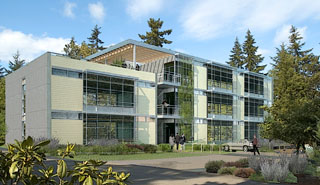
Surveys
DJC.COM
December 10, 2009
10 things I learned in Green Broker school
World West Investments

West
|
My awareness of green living has become a priority in my personal life since I first heard about the critical importance of sustainable building and development at a luncheon in 2008. The Certified Green Broker Program has taken my commitment many steps further — by learning to incorporate the principles of sustainability into my career as a commercial real estate broker.
Before completing the Certified Green Broker Designation, I became involved in the Madrona Offices (formerly Mile Hill Drive), a sustainable office building project in Port Orchard led by the award-winning design team at Weber Thompson. My enthusiasm towards the project grew as I witnessed the synergy that developed as team members suggested sustainable strategies and ideas for the project. This made me even more excited to take part in the Certified Green Broker Program, which was created about a year ago by the Commercial Brokers Association and Cascadia Region Green Building Council.
Experiencing the integrated design process first-hand created concrete learning for me through practical application and concentrated study.
Here is what I learned on my journey:

Image courtesy of Weber Thompson The 14,000-square-foot Madrona Offices in Port Orchard will be oriented on an east-west axis to maximize natural daylight and ventilation, and the potential for passive solar heat. |
1. Going green makes everything else greener. The benefits and significance of preserving, recycling and reusing precious resources, creating healthier indoor air quality, and using sustainable products and services creates a beneficial cycle of “greenness” that catches on and has even greater benefits.
2. It is not just about the sustainable products and services we use, but also how we use them. For example, a sustainable practice achieving maximum benefit would be having the janitorial staff clean offices during daylight hours to avoid nighttime energy use. Another practice achieving maximum benefit is deciding the best orientation of a building, during the planning phase, in order to maximize the use of daylight, which is energy efficient and healthier for employees.
3. Integrated design impacts everyone involved. Experience and study allowed me to develop a deep appreciation for the integrated design process and how all stakeholders including owners, marketers, designers, engineers and others have more of themselves vested in the project when brought in from the beginning.
Weber Thompson senior principal Scott E. Thompson says, “Sustainable building design requires the integrative design process. We must look at a building as a ‘whole system’ early on, exploring opportunities that can be easily and cost-effectively incorporated into our decision-making. Attempting anything less would be a compromise resulting in expensive solutions or disappointment down the line.”
4. Cost versus savings of going green. While there is a pervasive belief in the industry that a project cannot achieve green status without paying a premium over the cost of constructing conventional buildings, there are methods to evaluate the cost and savings of going green.
One of the most valuable things I learned from this course is that the integrated design process specifically addresses cost and savings over the life cycle of a building, from initial investment to disposal. With this perspective, we get a complete picture of financial impact, as opposed to an approach that limits analysis to merely first costs, because operational cost-savings increases the value of a project through an increase in its net operating income.
With this long-term view, we can look ahead and “future proof” a project. By considering, evaluating and incorporating various sustainable and cost-effective strategies, we achieve significant long-term savings. For example, when the design of a project includes natural ventilation, the project’s team could consider using a smaller heating and cooling system in order to save on operational costs; or with a geo-thermal system, the energy savings will decrease operating expenses and increase net operating income, which would eventually justify the expense of installing the system.
5. Green buildings might still underperform if occupants do not operate in a sustainable manner. Therefore, it is a duty of a Green Broker to recommend to developers, building owners and tenants that they include a tenant operations manual based on the LEED Commercial Interiors guidelines, as well as adopting the use of a comprehensive green lease.
6. Water is truly precious. Only .06 percent of the earth’s water is usable — the rest is saltwater or ice, which is difficult to use. I learned that using potable water for irrigation purposes is wasteful. For this reason, water management strategies are a top priority on my list of items to encourage within the context of green building and development.
In the case of the development project I am involved in, we are using innovative water reclamation and management strategies. Our goal is to construct a building that manages all stormwater runoff onsite using strategies that include a green roof, rain gardens and soil infiltration systems.
7. Getting green = getting social. Sustainability includes healthy social environments for work and social interactions. For example, The Madrona Office project will use a portion of its green roof as a common area for social gathering and interaction.
Tom Marseille, principal at Stantec and lead mechanical/energy engineer on the project, adds that creating “more livable spaces with outdoor views” is documented to result in “higher productivity and fewer sick days.”
8. Ensuring reliability of green claims. I now understand how to ascertain the reliability of green claims by checking for widely recognized eco-labels and building environmental ratings systems. This will help clients ensure that they are actually supporting green innovative products and services. Examples include LEED-rated buildings, Living Buildings, Energy Star and The Pharos Label.
9. Identifying the most marketable and easily attainable green strategies. I learned about evaluation methods that building owners can use to identify the most marketable and easily attainable green strategies. I am now qualified to advise tenants on evaluating green space and/or upgrading their existing space to “green.” Such strategies include retro-commissioning, energy and water audits, and pursuing LEED Commercial Interiors when the building itself is not sustainable.
10. Personal enlightenment. The thing that impacted me most upon completing the Certified Green Broker Program happened on a more personal level. I gained a greater sense of insight, enthusiasm and excitement for all of the ways Green Brokers can contribute to preserving the natural beauty of our land. I considered the possibility of losing this beautiful place that we live in by not having done everything we can, now, to preserve our planet. I realized that if we fail to act, light pollution, smog and the loss of trees would steal these very precious things from us and from our descendants.
I learned that we can make a difference by empowering ourselves with knowledge to help preserve the beauty of nature while maintaining the integrity of our built environment.
Suzette West, ABR, EBA, is an exclusive buyer’s agent in Port Orchard, Seattle and the surrounding areas of Western Washington. She specializes in commercial and investment real estate.
Other Stories:
- ‘Game changers’ show what’s ahead for commercial real estate
- Need a loan? Here’s what you should know
- Are you prepared for the big flood?
- Aigner finds calm after near-death experience
- A lean, mean, clean and green future
- Pioneer Square gets ready for change
- New office towers help CBD move north
- Sumner’s industrial market weathers the economic storm
- Retail’s bumpy ride starts to smooth out
- Is the recession for hotels ready to end?
- Further pain coming in the multifamily markets
- Bellevue’s office market more ‘fit’ than Seattle’s
- Relax; it’s only a business cycle
- Dean C. Allen
- William Pollard
- Chris Pratley
- Why the economic loss rule matters
Copyright ©2009 Seattle Daily Journal and DJC.COM.
Comments? Questions? Contact us.